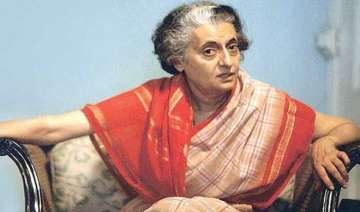‘Cool’ Indira Gandhi was changing bedcovers after 1971 war began: Book
New Delhi: A day after the India-Pakistan war erupted in 1971, then prime minister Indira Gandhi was so cool that she was changing the bedcovers on a 'diwan' when her personal physician walked in. "I

New Delhi: A day after the India-Pakistan war erupted in 1971, then prime minister Indira Gandhi was so cool that she was changing the bedcovers on a 'diwan' when her personal physician walked in.
"I had the occasion to see PM herself changing the bedcovers on the diwan," K.P. Mathur, now 92, says in his just released book based on the many years spent with Gandhi. "It was the day after the Bangladesh war had started and she had worked late into the night," says the book, "The Unseen Indira Gandhi" (Konark Publishers).
"When I went to see her in the morning, I saw her engaged in the exercise of dusting. Perhaps, it helped her release the tension of the earlier night."
The 151-page book is full of anecdotes that the former physician of Safdarjung Hospital here recalls from his nearly 20-year association with Gandhi till her assassination in 1984.
According to Mathur, when Pakistan attacked India on December 3, 1971, Gandhi was in Kolkata. She flew back to Delhi.
"During the flight, she was cool and composed as ever; her mind was obviously occupied with the strategy of war, the future course of action."
But the same Gandhi used to be nervous soon after she took charge as prime minister in 1966, the book says.
"During the first year or two of her becoming PM, she used to be very tense, a bit confused and not sure of herself. She had no advisors and was almost friendless...
"She would also get stomach upsets in the early days of being PM which I believe was the result of the same nervousness."
Mathur describes Gandhi as "a pleasant, caring and helpful person" who treated servants in her household well, addressing each one by his or her name. "Nobody was shouted for."
Read Also: Indira Gandhi most powerful PM of India: Suresh Prabhu
Gandhi lived a simple life with no sign of opulence. "Thrift was her guiding principle." She refused to move into Teen Murti House and added "a couple of rooms" only after Rajiv Gandhi married Sonia in 1968.
When she went on tours, breakfast was ordered from the South Indian Coffee House in Connaught Place.
After the Rajiv-Sonia marriage, "PM was very keen that Sonia should get into the social and cultural life of the country". She described Sonia as "bahurani" while speaking to others in the house.
Describing Indira Gandhi as "a loving mother, grandmother and an understanding and non-interfering mother-in-law", Mathur says Gandhi took an immediate liking for Sonia.
"PM and Sonia took to each other in no time... Sonia very soon took over the responsibility of running the (Gandhi) household."
Indira Gandhi would take it easy on Saturdays, the book says. And on Sundays and other holidays, she relaxed with books, especially biographies of great men.
She also liked books on subjects connected with the body and mind and was fond of solving crossword puzzles.
"Sometimes, after lunch, she liked to play cards. Her favourite card game was Kali Mam."
Mathur says that Gandhi accepted her defeat in the 1977 Lok Sabha election "gracefully".
"Initially, PM felt a bit lonely after losing the elections. She had nothing to do. No files would come to her...
"She had no office, no staff car or even a car of her own. The staff car allotted to her had been withdrawn and she had no telephone operator to help and she had forgotten the telephone numbers of friends."
The book says Gandhi was not only religious but also superstitious. She wore a rosary of rudraksha beads received from spiritual guru Anandmayi Ma.
"I am not sure whether PM performed a regular puja every day but she had framed pictures and small statues of many Gods arranged in a separate room with a small mat on the floor, presumably for her to sit on and pray.
"She would make it a point to visit every famous temple in any part of the country during her tours.
"She prayed at the Badri-Kedar and many south Indian temples. She had visited Tirupathi several times as well as Vaishno Devi, always fully observing the prescribed rituals."